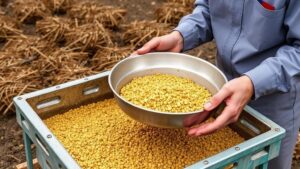The Role of Phase Separation in Extracting Gold From Polymetallic Ores
The Role of Phase Separation in Extracting Gold From Polymetallic Ores
Gold extraction from polymetallic ores involves complex processes, primarily due to the presence of multiple valuable metals and minerals. Among the techniques utilized in the gold extraction process, phase separation has emerged as a crucial methodology. This article explores the mechanisms of phase separation, its applications in extracting gold, and its implications for the mining and metallurgical industries.
Understanding Phase Separation
Phase separation refers to the process of separating different phases based on their physical and chemical properties. In the context of metallurgy, it generally involves the segregation of metals and their compounds during the extraction process. This can be particularly useful in the presence of polymetallic ores, where multiple metals are present in the same mineral matrix.
The primary types of phase separation include:
- Liquid-Liquid Separation: This method separates components based on differing solubilities in a liquid solvent.
- Solid-Liquid Separation: Here, the solid components of the ore are separated from the liquid phase, which contains valuable metal ions.
- Gas-Liquid Separation: This involves separating gas from liquids, often used in processes like flotation.
The Importance of Phase Separation in Gold Extraction
The polymetallic nature of ores presents several challenges in gold extraction. Traditional methods can often lead to inefficiencies, such as losses of valuable metals or the need for complicated refining processes. Useing phase separation can enhance resource recovery and improve overall efficiency.
For example, in the hydrometallurgical process, phase separation techniques such as solvent extraction (SX) are used. SX facilitates the selective extraction of gold from a mixture of metals using an organic solvent that preferentially binds to gold ions, allowing other metals to remain in the aqueous phase. This method can boast recovery rates exceeding 90% under optimal conditions.
Case Studies Demonstrating Phase Separation
Several mining operations have successfully employed phase separation techniques to enhance gold recovery from polymetallic ores. Notable case studies include:
- Barrick Golds Veladero Mine (Argentina): The use of solvent extraction has significantly increased the recovery of gold and other metals, optimizing the ore processing system.
- Rio Tintos Kennecott Utah Copper: This facility utilizes advanced phase separation methods to extract copper alongside gold, increasing the overall economic viability of the operation.
- Newmont Minings Tanami Operations (Australia): The implementation of selective leaching technologies has improved gold extraction rates by effectively separating gold from other minerals through phase separation.
Challenges and Considerations
Despite its advantages, phase separation is not without challenges. Potential concerns include:
- Environmental Impact: Chemicals used in phase separation can introduce hazardous materials into the environment if not managed properly.
- Operational Costs: The implementation of complex phase separation processes can lead to increased capital and operational expenses.
- Technical Limitations: Certain polymetallic ores may present unique challenges that reduce the effectiveness of conventional phase separation techniques.
Addressing these issues requires continuous research and development. Advanced modeling and simulation tools can provide insights into optimizing phase separation processes while minimizing environmental impacts.
Future Directions
The future of gold extraction from polymetallic ores will likely involve further advancements in phase separation technologies. Innovations such as bioleaching, where microorganisms assist in metal recovery, may complement traditional phase separation techniques. Also, researchers are exploring the integration of artificial intelligence and machine learning to optimize the extraction process, improving efficiency and recovery rates.
Conclusion
Phase separation plays a pivotal role in enhancing the extraction of gold from polymetallic ores. By employing various techniques such as solvent extraction and advanced leaching methods, mining operations can achieve higher recovery rates and efficiently separate valuable metals from complex mineral matrices. While challenges remain, continued innovation in this field promises to revolutionize gold extraction practices and contribute to more sustainable mining efforts.
Actionable Takeaways:
- Evaluate the use of phase separation technologies in current gold extraction practices.
- Invest in research to mitigate environmental risks associated with phase separation.
- Consider integrating new technologies such as AI to streamline extraction processes.


